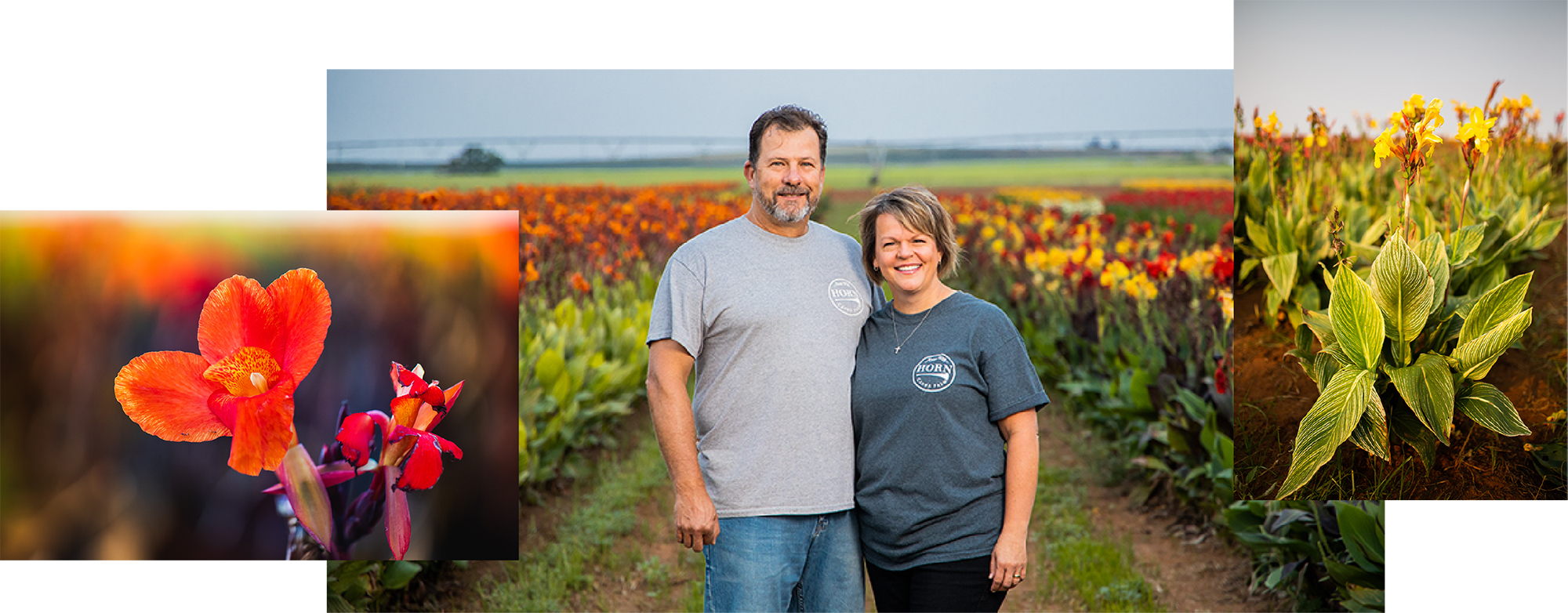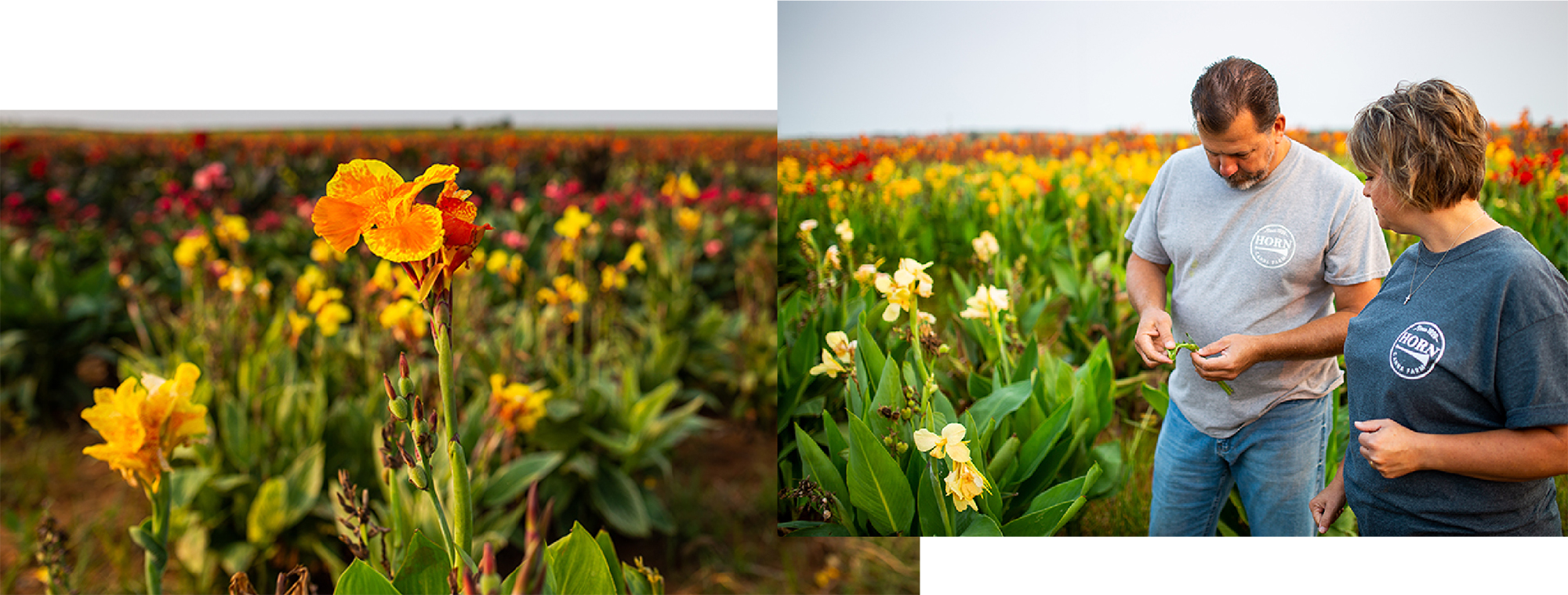The Horn’s & the Canna Stalk
CKenergy Electric Cooperative members Dustin and Nikki Snow find joy in providing beauty and purpose through the Horn Canna Farm

Do you remember the story of Jack and the Beanstalk? In this English fairy tale the exchange of a cow for some magic beans sounds ridiculous, but like many favorite fairy stories, all turns out well in the end. For an Okie version of the tale—and this one is true—the story of John Horn and the canna bulbs starts with an exchange of a cow for a field of flowers.
In the 1920s, John and Frances Horn were farming in Caddo County near Carnegie. It was a hard-scrabble life, raising vegetables and melons and peddling them.
“My grandmother had an aunt in Arkansas who imagined her niece was living in a desert at the end of the world. To cheer her, she sent my grandmother six canna bulbs,” Jolene Horn Snow, CKenergy Electric Cooperative member, says.
Frances planted the bulbs which grew, bloomed and flourished—and produced enough bulbs that John began taking them on his vegetable route and selling them. At the age of 15, their son Neil (Jolene’s father) traded his father a Jersey calf for the rights to the canna business, which became Horn Canna Farm.
Jolene Snow describes her father as a real character, a dreamer, eccentric, and an inventor. He brought the first irrigation system to Caddo County and adapted all sorts of farm equipment—from potato diggers to sugar beet pickers—to fit the needs of the cannas. He and his wife, Louise, expanded the operation to over 100 acres.
After Neil’s death in 1988, Jolene and her husband, Butch Snow, joined the business, which they bought in 1993. The Snows sold bulbs, both retail and wholesale, with their largest customers being bulb and seed companies and nurseries. Their markets were international. American customers of big companies in the Netherlands could actually be buying canna bulbs shipped from Carnegie, Oklahoma, and shipped back to the states.

The fourth generation of the family, Dustin and Nikki Snow (also CKenergy Electric Cooperative members), joined the business in 1994, adding computer skills to make office tasks easier. Butch and Jolene retired in 2008 and Dustin and Nikki Snow became owners. They continued the business, increasing the planting area to over 200 acres. Things were going well with sales up to 4 million bulbs in a peak year.
Several years of drought followed. Then there was a devastating windstorm.
“The winds blew at a sustained 70 miles an hour for 48 hours straight,” Dustin Snow says.
Sandy soil from fallow fields sand-blasted everything. Thirty percent of the canna crop was destroyed. In addition, large corporate customers were becoming more difficult to deal with. The combination of a slim profit margin combined with the hassle of shipping was making that part of the business less profitable.
The Snows were re-evaluating their business plan, even wondering if the business would survive, when the pandemic hit. Although the virus had been in the news, reality seemed to set in when the Thunder game in Oklahoma City was cancelled on March 11, 2020.
“We wouldn’t have made the decision on our own, but, because we were forced to, we had to transition,” Nikki Snow says.
That meant seriously downsizing and concentrating on retail sales to individuals.
In a typical year, the Snows would be shipping bulbs from February through June. In Oklahoma, the ideal time to plant cannas is in April, after the last freeze. In the midst of the disaster, there was a silver lining.
As people found themselves spending more time at home, they were looking for pleasure in their yards and gardens. Online orders began pouring in.
“We can’t celebrate when so many people are suffering,” Nikki Snow says. But the couple finds joy in providing beauty and purpose during this grim time.
And there’s real pleasure in dealing with people one-on-one rather than with large businesses. Both of the Snows are gracious about answering questions from first-time gardeners and giving advice on canna care.
Cannas bloom from July through September. Most home growers simply leave the bulbs in the ground and let them spread. While they typically survive the Oklahoma winter, the severe February freeze this year did kill some cannas. Retired owner Jolene Snow, who lives in nearby Eakley, had a large canna bed but lost most of her plants during the coldest weather.

At Horn Canna Farm, the bulbs are harvested every October. Dustin adapted a peanut digger to bring the bulbs to the surface, and then uses a customized tomato harvester to pick them up. Bulbs are washed and sorted and prepared for storage. The severe cold was also a problem at the farm.
“It was brutal keeping the barns warm enough. We had to move the canna bulbs away from the walls in the barns,” Dustin says. “In the greenhouse where we had started the live plants, we had to set the thermometer at 100 degrees to keep the temperature at 40.”
The biggest and best bulbs are set aside for customers. The Snows save about a quarter of the bulbs; the pieces too small to sell are saved for planting the next year. Each bulb can produce two to five more bulbs a year.
With a reduced area for the cannas, the Snows are doing several different things with the rest of their land. They are working to take better care of their soil—rotating crops and planting some areas with Bermuda grass. Last year and this, they added a large area of sunflowers.
September is the prime time to see the cannas—and the sunflowers. Visitors who call ahead will be able to arrange a tour. Those wanting to go into the sunflower field are charged a small admission fee. Although 98% of their sales are online, bulbs are also available at the farm from March through May.
Altogether, over 100 varieties are growing at Horn Canna Farm. They sell 35 varieties of bulbs; the rest of the varieties are on trial to determine the best for Oklahoma. Cannas range in height from 3 to 8 feet and come in a number of colors—red, orange, yellow, pink and white. Foliage can be green, bronze or variegated. Live plants are available from May 1 through August 31.
With five offspring, the Snows hope the farm will continue for future generations. It’s a hard life, but they find it very rewarding. This year they have even more cause to be grateful. Nikki shares the enjoyment the cannas have brought to new customers.
“I’ve never been thanked for doing my job. People say, ‘Thank you for all the hard work you do so I can have a pretty yard.’ I’ve never heard that in all the years I’ve worked on the farm,” she says.
In the fairy tale, Jack’s efforts brought him a goose that laid golden eggs. The Snows, too, have a reward in helping to bring beauty to Oklahoma families.
Sign up for our Oklahoma Living Newsletter


